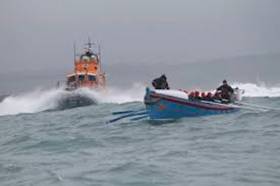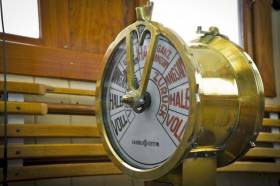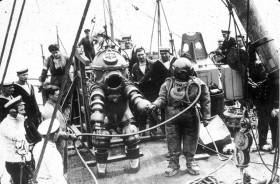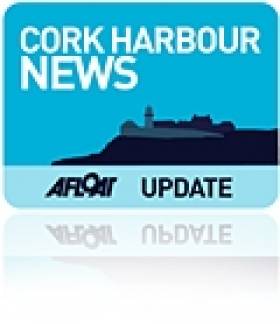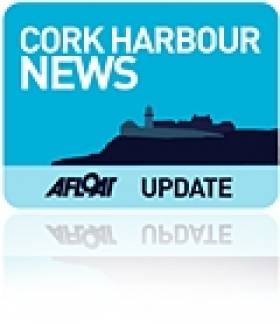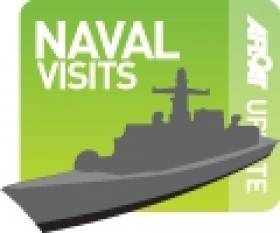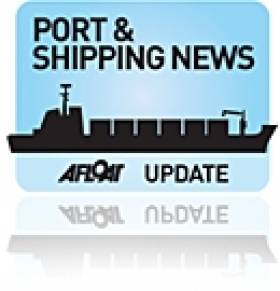Displaying items by tag: Lusitania
#RNLI - For more than 100 years, the crews of Courtmacsherry Harbour Lifeboat Station have laid a wreath over the site of RMS Lusitania.
In Courtmacsherry Bay, the old British Royal Navy watch tower of the Seven Heads peninsula is the closest point of land to the Lusitania tragedy at 11.2 nautical miles.
Courtmacsherry Harbour is also home to a one of the earliest established lifeboat stations in Ireland, founded in 1825, and at the time of the Lusitania tragedy located at Barry’s Point in Courtmacsherry.
On 7 May 1915, the Lusitania, a British Cunard line ocean liner, was on passage from New York when she was torpedoed and sunk by a German U-boat south of Courtmacsherry Bay, with the loss of 1,201 lives.
The Courtmacsherry RNLI volunteer lifeboat crew was alerted to the tragedy and due to the fine weather that day, the sails were of no use, so they rowed the Kezia Gwilt lifeboat to the scene of the sinking.
The sea was strewn with the dead, some with lifebelts on, others holding on to pieces of rafts. The volunteers of the Kezia Gwilt spent six hours on scene, taking bodies from the water.
In 2015, the present lifeboat crew and residents of Courtmacsherry village, many of whom are related to the original 1915 lifeboat crew who were called to service, staged a re-enactment of that heroic row by the then lifeboat crew to the site of the Lusitania.
Since that ill-fated day in 1915, the crew of Courtmacsherry RNLI annually pay tribute to those lost by laying a wreath over the wreck of RMS Lusitania.
If anyone would like the crew to lay a wreath on their behalf for those lost on the Lusitania, they can bring it to Courtmacsherry Harbour Lifeboat Station before 12.30pm on Monday 7 May.
#Lusitania - The main ship’s telegraph from the Lusitania has been recovered from the wreck site off West Cork.
Heritage Minister Heather Humphreys made the announcement last Wednesday (26 July) as the telegraph was undergoing preliminary conservation on shore by the National Monuments Service.
Earlier in the week, divers licensed by the minister — and with the consent of the wreck’s owner, American millionaire Gregg Bemis — had spotted the device feared lost after a botched retrieval operation last year.
“I am happy to confirm that this important piece of the Lusitania has now been recovered from the wreck off the West Cork coast,” said Minister Humphreys. “I understand that the telegraph is undamaged and in excellent condition.”
Bemis intends to place the telegraph, along with its pedestal successfully recovered last ear, on display in a local museum along with a number of other artefacts from the wreck.
Questions were raised by an Oireachtas committee in March after the telegraph was lost from a burst lift bag during an unsupervised dive off the Old Head of Kinsale last summer.
Another telegraph from the ill-fated liner, which was torpedoed by a German U-boat during the First World War, was recovered later in 2016.
#Lusitania - Questions have been raised by an Oireactas committee after a telegraph from the Lusitania wreck was lost during an unsupervised dive last summer.
According to RTÉ News, no archaeologist was present on the diving expedition on 13 July 2016 during which the telegraph sank to the ocean floor from a burst lift bag.
The committee heard from Terry Allen of the National Monuments Service that the incident would have occurred even with supervision by an archaeologist.
But committee chair Peadar Tóibín said Heritage Minister Heather Humphreys has “questions to answer” as the decision to allow the dive to one of Ireland’s most important wreck sites unsupervised was itself a “significant break” from protocol.
A subsequent dive led by Eoin McGarry on behalf of the Lusitania’s owner Gregg Bemis recovered a separate telegraph machine from its bridge, as previously reported on Afloat.ie.
Diver Recovers Telegraph Machine From Lusitania Wreck
#Lusitania - A Dungarvan diver has recovered a telegraph machine from the wreck of the Lusitania off West Cork, as The Irish Times reports.
Eoin McGarry retrieved the treasure trove under licence from the Heritage Minister and on behalf of the wreck’s owner, multi-millionaire US businessman Gregg Bemis, who hopes to restore it for display locally.
The find completes a diving operation that began this past summer with the retrieval of part of the bridge telegraph — which Bemis and McGarry plan to return for in the new year.
Last month marked 81 years since the discovery of the Lusitania wreck site off the Old Head of Kindle, as previously reported on Afloat.ie.
81 Years Since First Incredible Dive To Lusitania Wreck
#Lusitania - Yesterday (Thursday 6 October) marked 81 years since the discovery of the wreck of the Lusitania off the Old Head of Kinsale, more than 20 years after the ocean liner was lost.
And less than three weeks from now will mark the 81st anniversary of the first brave diving expedition to the wreck site, according to Coast Monkey.
A far cry from the SCUBA gear and technology used by modern-day divers, Jim Jarrett made his descent in an enormous Tritonia diving suit.
The JS Peress design resembles something out of the sci-fi movies that would come out of Hollywood decades later.
But it was necessary to enable Jarrett to withstand the incredible pressures at the wreck site some 93 metres below the surface.
Coast Monkey has more on this remarkable story HERE.
#Lusitania - This week saw the centenary of the sinking of the Lusitania marked with commemorative events in Cork Harbour, including a ceremony in Cobh led by President Michael D Higgins and a cruise call by the Cunard Line's Queen Victoria as part of its 'Lusitania Remembered' voyage.
New sonar imagery showing the full extent of the wreck site off Kinsale was also revealed this week, displaying its current condition on the sea floor in greater detail than ever.
A hundred years after it slipped below the waves, the ill-fated liner is only "beginning to reveal its wounds, scars and perhaps its secrets, and may continue to do so for many years to come," according to Government officials.
One man who's long hoped for such secrets to be revealed is the wreck's owner Gregg Bemis, who sent a personal tribute to be delivered instead of attending the official commemoration.
The multi-millionaire American businessman is currently at odds with the State over what he describes as "spiteful" the strict licensing rules imposed on his long-planned return dive to the wreck.
Bemis intends to disprove the findings of National Geographic's 2012 documentary on its so-called 'dark secrets', in his belief that there was more to the second explosion that sealed its fate than a damaged boiler.
His story is the subject of a detailed profile in the latest Fortune magazine. And more recently he wrote a scathing piece in The Irish Times, highlighting the "double standard" in the lack of public expenditure on researching shipwrecks in relatively shallow waters such as the Lusitania and the Estonia, which sank in the Baltic in 1994, compared to the multiple millions spent over many years on plane crash sites to determine their cause.
Bemis had more to say to The Irish Times' Lorna Siggins about his deep research into the Lusitania controversy, and whether it really did carry a clandestine arms and munitions shipment which may have made it the target for the German U-boat that blasted its hull.
While the owner did not travel to Cork Harbour himself, diver Eoin McGarry went in his stead to place Bemis' tribute plaque with the names of the hundreds who died in the tragedy, as well as a single red rose, near the remains of the ship's bridge.
McGarry – who has descended to the wreck more than anyone else – willingly paid the harsh decompression penalties to return to what's regarded as the Everest of diving, according to fellow diver Tim Carey.
"The first glimpse of the vessel is a huge feeling of exhilaration," Carey writes in the Irish Independent, adding that "swimming around the wreck is a very touching experience and is like transcending time".
However, he also warns that "diving the wreck over a ten-year period has shown me one inescapable fact - the wreck is constantly corroding and collapsing further and is suffering a lot of damage from fishing nets."
Which means that the preservation of its remaining artefacts, if not the revelation of its deepest secrets, must be secured before it's too late.
#lusitania – President Michael D Higgins will lead a commemoration event in Cobh on Thursday, 7th May to mark the centenary of the sinking of the Lusitania. The event, which will also be attended by a number of other VIPs including the British, German and US ambassadors to Ireland is expected to see a large turn-out and the public are advised that traffic and parking restrictions will be in place throughout the day.
Road closures will be in effect in Casement Square and on part of Westbourne Place from 11.30am until 10.30pm.
Captain Michael McCarthy, Commercial Manager of the Port of Cork who is lead organiser of the event said "We expect that up to 10,000 people from across Ireland and beyond, many of whom have personal connections to the Lusitania disaster, will descend on the town of Cobh to remember all those who lost their lives on the 7th May 1915. For anyone intending on travelling to the event, I would urge them to take the train as it is the easiest and most direct way to get to the heart of Cobh town where events will be taking place."
Irish Rail will be running additional services throughout the day on the Cork - Cobh line giving a service every 30 minutes from 06.30hrs until 19.30hrs. Cobh can also be accessed from stations at Midleton, Carrigtwohill, Little Island and Glounthaune, where free parking is available. For train timetables and for further information, please see www.irishrail.ie
Superintendent John Quilter said "Additional Gardaí will be in place for the day and will be aided by event stewards to ensure that everyone who attends has an enjoyable and safe experience. I would encourage all those travelling to Cobh to plan their travel in advance and to check for updates in relation to parking and traffic restrictions."
The main points are as follows:
· No parking at Westbourne Place and Casement Square.
· One way system going into Cobh along the High Road.
· One way system going out of Cobh along the Lower Road.
· Disabled parking is outside the Sirius Arts Centre on Lower Rd. – display badge and follow signage.
· Obey Directions of Gardaí and stewards at all times.
· Secure vehicles and don't leave valuables in them.
· Where applicable, display parking badges clearly en route to the event.
· Parking will be available at the Verolme Cork Dockyard adjacent to Rushbroke rail station. Additional parking will be available at Cobh Pirates Rugby Club and the Cathedral car park.
The Cross-River Ferry will run two vessels throughout the day for those travelling from the west side of the harbour.
#CorkHarbour - Following today's earlier news of a French naval visit to Dun Laoghaire Harbour comes word from TheJournal.ie of a courtesy call by the German navy at Cork Harbour this weekend.
Seven German vessels will be stopping by till Monday 27 April restocking supplies and giving their crews some well earned shore leave.
But they're also sure to pause and reflect on the 100 years since the sinking of the Lusitania by a U-boat representing a very different Germany in the First World War.
Commemorations for those who died in the tragedy began in Cork Harbour on 1 February and will continue till the anniversary on 7 May.
State Rules Hindering Lusitania Return Dive Says Wreck Owner
#Lusitania100 - The multi-millionaire businessman owner of the Lusitania wreck claims the State has left the site vulnerable to treasure hunters while preventing his own return dive to recover artefacts.
As RTÉ News reports, Gregg Bemis described as "spiteful" the strict rules imposed on his planned return to the wreck to retrieve objects of value and historical importance.
He also aims to disprove the findings of a 2012 documentary on the fate of the Cunard liner that was torpedoed by a German U-boat off the Old Head of Kinsale on 7 May 1915 – which claimed a second explosion on the ship reported at the time came from a boiler in the vessel's bowels, and not from its alleged munitions cargo.
But Bemis says Government officials "are so glib and innocent sounding like they walk on water, but they add all these restrictions on and throw them at me so they interfere and impede."
That's despite securing the endorsement from then Heritage Minister Jimmy Deenihan for a return dive two years ago.
What's more, Bemis' previous dive team leader Eoin McGarry fears the wreck site may already have fallen victim to pirates seeking artefacts such as the ship's steam whistle and the captain's personal safe.
However, a statement from the Government said the conditions of Bemis' licence "are no more onerous than is absolutely necessary to protect a wreck of this global significance."
The controversy comes as Cork prepares to recognise the centenary of the Lusitania disaster, already the subject of a museum exhibition in Liverpool.
RTÉ News has more on the story HERE.
New Lusitania Research Changes Data - Merseyside Museum
#lusitania – An exhibition opening at Merseyside Maritime Museum on 27 March called Lusitania: life, loss, legacy will highlight little-known data that changes the commonly used figures of the last 100 years, when referencing the crew and passengers on Lusitania's final voyage.
Omitted from the previous official figures for Lusitania are Fireman Gontes Cloules, Waiter F. Hill and passenger Robert Anderson, taking the figures for people on board from 1,959 to 1,962.
In the days following the sinking, newspapers reported numerous lists of survivors and victims, obtained from various sources. It was March, 1916 when an official booklet known as the 'Cunard Confidential Report' was published, which became the official source. However, it was discovered very early on that this report contained errors, and there were at least two subsequent amendments to this, the last-known published in March 1917.
Gontes Cloules, Waiter F. Hill and passenger Robert Anderson were not included in the official lists of crew and passengers, and are therefore not reflected in the numbers widely used in reference to the tragic sinking of the Lusitania on 7 May, 1915.
Independent historian Peter Kelly has searched records over the last 10 years to bring them back into public consciousness. This and other findings of Peter's, have given us a new level of detail about passengers and crew aboard Lusitania, and will be included in the new exhibition at Merseyside Maritime Museum.
Peter Kelly said: "The figures have always been out there, except that not many of us have looked for them or been able to find them. It's not unusual for records to have been incomplete or incorrect in those times. It was an age before technology, when passenger names were often taken phonetically and misspelt, or maybe people were travelling under a different name.
"I'm not alone in researching this data and trying to tie it down so that everyone who was on-board Lusitania is recognised - whether they lost their lives when the ship went down, or survived this terrible tragedy. We all have our various theories on the names of a number of people who are recorded as having sailed on the ship, and it's a difficult process to work through due to the amount of records and personal accounts out there, some of which provide conflicting information.
"I'm at the point now where the research I've done has led me to believe these new figures are true, accounting for the three extra people that were on-board. The story of the Lusitania has always had some mystery surrounding it, and if more information comes to light about those who were on-board, the figures will be updated again."
Peter's figures will be included in the exhibition as part of an interactive resource, which can also be accessed by the public online from 27 March. The resource is such that any new data and information can be added in the future.
Ellie Moffat said: "This story of the Lusitania is so important here in Liverpool. The ship was the jewel in the city's crown and more than 600 people on her final voyage had connections with the city and wider region. Many people living today are still profoundly affected by the account of a relative who went through the sinking. When Peter came forward with his research, we were thrilled, because we want to share as much, and as complete, information as we can with the city, and with anyone connected to the ship."
General findings:
Total number of people on board:
1962 (total people previously – 1959*)
Everyone on board:
Survived: 771 (survived previously – 761*)
Lost: 1191 (lost previously – 1198*)
Comparison passenger and crew survival rates:
Passengers: 480 survived, 786 lost - 1266 total passengers (total passengers previously 1257*)
Crew: 291 survived, 405 lost - 696 total crew (total crew previously 702*)
* The 'previous official figures' refers to data taken from Cunard's official list of crew published by The Cunard Steam Ship Company in March 1915 and list of passengers lost and saved published by The Cunard Steam Ship Company in March 1916.
Fireman Gontes Cloules
Gontes Cloules was born in Malta in 1891 and lived at 99, Vicnarsa Hania, Malta.
Although the records of the Commonwealth War Graves Commission show that he served on-board the Lusitania as a Fireman in the Engineering Department and was killed when the ship was sunk, he does not appear in the Cunard Steamship Company's list of crew members, either missing or having survived.
However, a Cunard list of crew members who engaged at New York on 30 April 1915 includes the name Cloules Goutes, who signed on as a Fireman at a monthly rate of pay of £4-5s.-0d. Presumably some mistake was made and Goutes was thought to be his surname. The names are too similar for it to be anything else, although there is no Goutes listed amongst the missing either.
The name Gontes Cloules is embossed on the Mercantile Marine Memorial at Tower Hill, London. The register for the memorial does not record any verifying details of his age, family or home.
Waiter, F. Hill
F. Hill (forename not known), was born in Glasgow, Renfrewshire Scotland, in the latter half of the nineteenth century.
He was a professional sailor in the Mercantile Marine and in April 1915, he had engaged to sail to England from New York on the Cunard liner S.S. Cameronia. However, at the end of that month, the Cameronia was taken up from trade by the British Admiralty for war work and on 1 May 1915, all the passengers and cargo and some of the crew were transferred instead, to the Lusitania, then awaiting what became her final transatlantic voyage at Pier 54 in New York harbour. Waiter Hill was one of these crew members and was offered the monthly rate of pay of £4-5s.-0d. (£4.25).
Six days out of New York, when she was off the southern coast of Ireland, the liner was torpedoed and sunk by the German submarine U-20, only hours away from her Liverpool destination, but fortunately, Hill was counted amongst the survivors.
Having been rescued from the sea and landed at Queenstown, he eventually made it to Liverpool where he was officially discharged from the Lusitania's last voyage and paid the balance of wages owing to him. This was in respect of his sea service from 1 May until 8 May 1915; 24 hours after the liner had gone down.
An official list of crew known to have been on board the Lusitania when she was sunk and published by The Cunard Steam Ship Company in March 1915, does not mention Waiter Hill at all, but he does appear in a Particulars of Discharge ledger held in the Public Record Office at Richmond in Surrey.
Robert Anderson
Robert Anderson was born in Ireland in 1875. He was a provision merchant and in 1915, he had been living and trading in New York, N.Y. in the United States of America.
In the spring of 1915, he decided to return home to Ireland - and consequently booked third class passage on the scheduled May sailing of the Lusitania, from New York to Liverpool.
He arrived at the Cunard berth at Pier 54 in New York harbour on the morning of 1 May 1915 - with ticket number 1807 - only to find that the liner's 10.00 a.m. departure had been delayed. This was because she had to wait to embark passengers, crew and cargo from the Anchor Lines vessel the S.S. Cameronia, which the British Admiralty had requisitioned for war service as a troop ship at the end of April.
The Lusitania finally left port just after midday and six days later, on the afternoon of 7 May, she was torpedoed and sunk by the German submarine U-20. At that time, she was only about 250 miles away from her destination and within sight of the coast of southern Ireland.
It was probably the closest that Robert Anderson would get to his homeland as he was killed as a result of this action. As his body was never recovered from the sea and identified afterwards, he has no known grave. He was aged 40 years.
He does not appear in the list of passengers lost and saved which was published by The Cunard Steam Ship Company in March 1916, but he is on a list compiled by the company at a later time and updated as late as February 1917, now held at The Public Record Office at Richmond in Surrey. This record has been found to be a more reliable source.


























